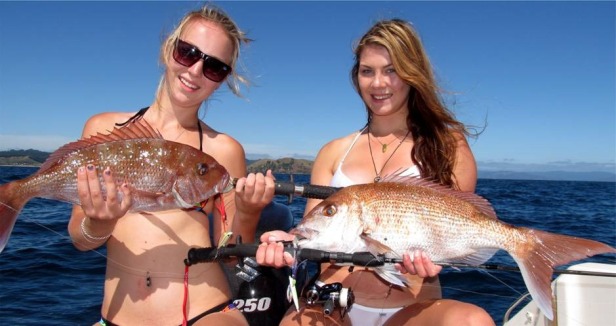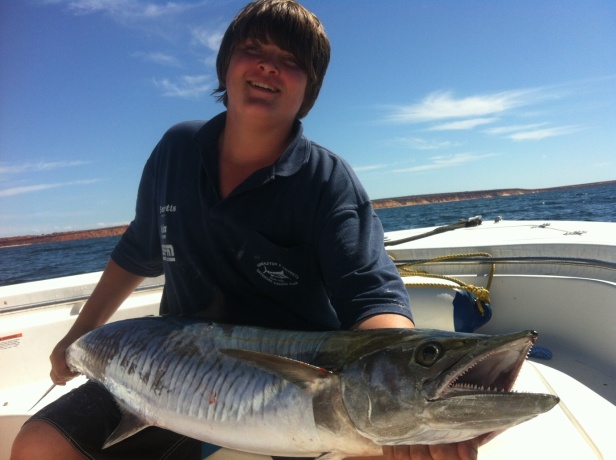Slow pitch jigging has spread around the globe like wildfire in the last few years.
First developed by Norihiro Sato in Japan, many variations exist now, some great and others, well, maybe slightly less so …… personally I favour Sato’s method with rods from Hamachi’s Zenku or XOS Gt’n’Doggie range with high super carbon content.
They have the perfect stiffness and ultra-fast recovery of these new hi-tech rods, the rods in the Hamachi range I personally prefer being the Zenku 7’ and 6’2 in PE1-3 and 0.5-3 and the 6′ XOS GT’n’Doggie PE1-3 or 2-4 with these ultra-fast rods proving to be my main weapons of choice.
In certain situations high-speed jigging is not only my preferred option, it’s the only option, BUT a day of high-speed jigging is tough on the body, particularly deep water with big jigs say 300gm to 600gm’s- wow you feel it the next day. It doesn’t matter how tough an egg you are, several hours of high-speed mechanical jigging, especially in the heat of our Australian climate, is hugely draining.
But if you’re looking for some more relaxing options, seeking to entice many of the slower moving bottom dwellers from the grouper and cod families right through to classic inshore freezer fillers like snapper, or even fish that aren’t in feed mode, then slow pitch jigging could be for you.
 Hawaiian Islands designs Ninja jigs are a multi-use run off the centre ring they are a deadly slow pitch and off the front tow eye they convert to an irresistible high speed offering
Hawaiian Islands designs Ninja jigs are a multi-use run off the centre ring they are a deadly slow pitch and off the front tow eye they convert to an irresistible high speed offering
 Snapper nail Ninjas without hesitation.
Snapper nail Ninjas without hesitation.
The law of the jungle (or the seas in this case) see the small and the weak as an easy meal, and a slow pitch jig aims to imitate these, mimicking the crippled movement of a wounded baitfish or the stop-start darting of a terrified one looking for the nearest cover. Either way, that spells “breakfast” to any predator in the sea. Hawaiian Island Designs make the absolutely perfect selection of jigs in their sub 150gram size Ninja’s for this
Slow pitch jigging is not slow reeling. It is a medium to fast crank in a slow tempo or rhythm, around 1 pitch per second, a tempo that is very slow compared to the conventional style of jigging. Where many fishers go wrong is they jig the rod up and down, the art is to actually push the rod away from you keeping it parallel to the water to create the rod load and the irresistible action in the jig. Think lunging with a duelling sword.

Yellowtail Kingfish are a prime target for slow pitch jigging
Where do I start?
Firstly the reel. Pitches range from a ¼ handle crank to a full rotation of the handle, two factors come into play here as to what you use, the gear ratio of the reel , a ¼ turn on a 7:1 reel will have far more movement than a ¼ turn on 3.5:1 reel, personally I use reels around 5 to 6 to 1 this allows plenty of speed for jigging without making the reel to fast that it risks stripping the gears on big fish.
Then work out your rod action keeping it parallel to the water, lunge it straight out from yourself up to 45 degrees either side of you. Personally, I mix it up- no set pattern as the aim is to imitate a natural lunging movement of the lure, with significant action to either side. Say from 45 degrees to my left pivoting for the next pitch anywhere up to 45 degrees to my right, or series of 4 or 5 pitches to cover the same arc, but no matter what action or direction you choose, remember to keep the rod parallel to the water!
Don’t be quick to pick up the slackline, most of your strikes with slow pitch, with the fish hitting on the drop…. the fish see a fluttering jig, think about it … that is a wounded and dying baitfish every time.
Slow pitch is also very effective on schools of snapper sitting off the bottom in “sleep mode”, using depth finder style braid (colour changes every 10 meters) , drop the jig to the bottom count the colours back on to the reel until the jig is in the strike zone and slow pitch away! How many times have you found what looks like home run school and cranked away with high speed and the only thing you’ve returned to the dock with is a sore arm?
 The lumo underside on jigs, like Hawaiian Island Ninja’s, are great for slow pitch on a night fishing expedition
The lumo underside on jigs, like Hawaiian Island Ninja’s, are great for slow pitch on a night fishing expedition
 Great selection of Hamachi jigs ideal for slow pitch jigging in 10 to 50 meters
Great selection of Hamachi jigs ideal for slow pitch jigging in 10 to 50 meters
Slow pitch jigging has achieved tremendous results with all kinds of fish. Groupers, cod, snapper, trout and other bottom fish are hard targets for a conventional style of jigging. But now these delicious fish are dedicated targets with Slow Pitch Jigging. But the fun doesn’t stop there, with Dogtooth tuna, yellowtail kings, GT’s, mackerel and other fast moving bullets of the ocean readily nailing slow pitch jigs.
 Hamachi crossover carbon jig rod loaded up in the shallows, note the rod butt tucked under the armpit
Hamachi crossover carbon jig rod loaded up in the shallows, note the rod butt tucked under the armpit
 Slow pitch isn’t just for bottom dwellers, oceanic speedsters can’t help themselves
Slow pitch isn’t just for bottom dwellers, oceanic speedsters can’t help themselves
Like high speed jigging the need to keep the jig vertical is critical in achieving maximum results, 3 options for the boat come into play here- anchoring, or the skipper holds the boat over the school with the engine, or my personal choice, where many of the bottom dwellers we seek aren’t a schooling fish, is to drift over the fish sign or structure, but to cast the jig ahead of the boat enough that it’s on the bottom and vertical when the boat reaches it, this is a great way to cover a long stretch of deep coral foul.
The Gear
When it comes to fitting out for Slow pitch jigging the most important part is the rod, as this is what creates the action , a specialist slow pitch rod is by far the best way to go as they will out-fish an all round or speed jig rod hands down. Sure in the shallows you can get away with an all-rounder jig rod and the difference in catch rate isn’t significant, but north of 40 or 50m deep without the specifically designed top ¼ of a slow pitch jig rod the jig will lose most of the action you are looking to impart.
Please do yourself a huge favour and stay with proper Japanese jig rods rather than western offerings. Japanese blanks are designed with the maximum performance of the rod being achieved when fished with the butt section tucked under your armpit. This enables the rod to be held parallel to the water essential for effective jigging. Yes, your local rod builder may be able to knock you up something, however, unless it’s on a Japanese blank a proper high end Japanese slow pitch rod will easily out fish it, even then I would still stick with the likes of Hamachi as all they do is build rods for Japanese fishing techniques day in day out and have done for over 20 years.
Reels, look for a quality reel. if you can afford a Shimano Stella then go for it, but a Shimano FJ Stradic 5000 or Daiwa Sol II at a quarter the price is more than up to the job for PE1-3 and there’s many options in conventional reels as well, again stick to well made 5 or 6 to 1 gear ratios particularly in PE5 and above setups. The Hamachi Agera 5000swx is another great PE3 option
Whilst most jigs can be easily adapted and used for slow pitch that extra edge will come from using a designed and made to purpose slow pitch jig, I can’t go past the Hawaiian Island Designs Ninjas as they are set up with two connecting points one for speed and the other for slow pitch
Shallow water (0 – 50m) sports outfit for up to 50 / 60lb fish
Rod
- Hamachi XOS GT’n’Doggie 6′ PE1-3 slow pitch
- Hamachi XOS GT’n’Doggie 7’6 PE2-4 crossover
- Hamachi Zenku 7’ / 6’2 PE1-3 (an all-round jig rod)
Running 20 or 30lb braid and jigs to 90 grams
Medium water (50 – 150m) sports outfit for up to 50 / 60lb fish
Rod
- Hamachi XOS GT’n’Doggie 6′ PE1-3 slow pitch
- Hamachi XOS GT’n’Doggie 6′ PE2-4 slow pitch
Running 20 or 30lb braid and jigs to 120 grams
Deep water (50m – 400m) sports outfit for unlimited
Rod
- Hamachi Nano XOS GT’n’Doggie 5’6 or 6′ PE3-8 or PE5-13
- Hamachi Nano Xylimum Jig 5’6 PE3-8 or 4-10
Running 80 or 130lb braid and jigs to 600 grams
As in all fishing, there are no hard and fast rules in how you use your lures, and one very sneaky trick is to add just a wee taste of bait to the hooks on the Ninja style jigs…the fluttering small squid skirt with a wafting scent of blood in the water really rings all the bells of every meat-eating fish in the ocean, and can turn a slow bite into a hot session in very short order.
Hopefully, I have not oversold it, but take the time to properly learn slow pitch fishing and I assure you, you will be richly rewarded for the time and effort. This is a deadly technique, one easy to pick up, and for an easy action, low energy input fishing technique, it sure pays off big time in superb table species of fish.


Great article
Got one of the new Hamachi XOS GT’n’Doggie slow pitch / fast punch PE1-3 killer rod !
Perfect for this type of jigging great from both slow drift or spankered boat (traditional Japanese set up for jigging)
LikeLiked by 1 person
do you know how I can get ahold of Hawaiian island design? their jigs appeal to me and I am local Oahu charter boat captain
thanks
LikeLiked by 1 person
Hi Chuck, FishingAndBoatingDeals.com used to carry them as I understand Hawaiian Island designs are no longer available. If you let me know what fish, depth and line class I might be able to recommend a few others that will do the trick for you
LikeLike
Would a Hamachi PE5-13 Xylimum Xtreme rod be useful in slo jigging scenerio. Someone gave me this rod as a gift – Haven’t rigged rod or fished with it yet. It’s only 1.8m
LikeLiked by 1 person